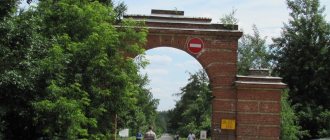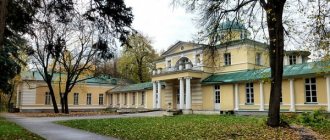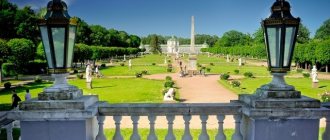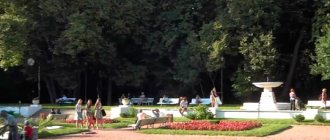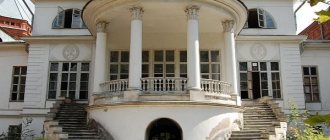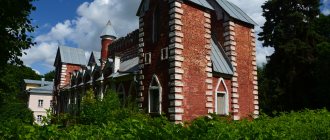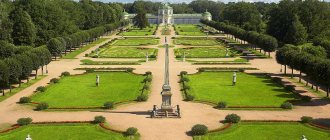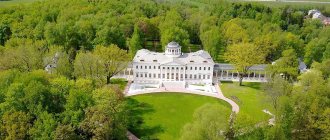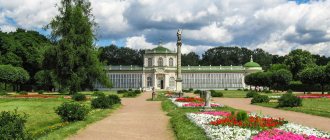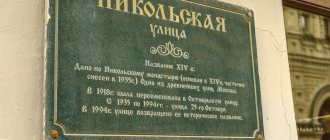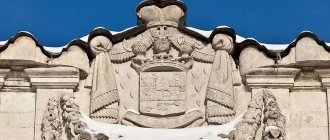A guest from the past - the Rostopchin estate
A white couple spun in a waltz, in a beautiful dance, graceful as steel. Their moment continued until, settling down, They could see the forbidden distance.
And after that the whole world was covered with a white shawl of thousands of them. That waltz remained in the memory of many, however, like thousands of thousands of others.
But the waltz continued, there was no sadness, That the only dance they would have. They decided so, whispered with their lips, That they were happy, but their dance died down. Shiryaeva A. Yu.
The click of heels, the rustle of ball gowns... A hundred years ago, gentlemen and ladies who had arrived for balls or literary meetings climbed the stone steps of the stairs in the estate on Bolshaya Lubyanka. Now only the wind is blowing through its corridors, plaster is falling off the walls and ceilings. In the very center of the golden-domed area, among boutiques and coffee shops, is the ancient estate of Count Rostopchin.
More than 40 ancient estates have been preserved in Moscow. Some of them are open to visitors; those who wish can examine their interiors and imagine how their owners lived a hundred or two hundred years ago. However, not all ancient buildings can accommodate guests and excursion groups. Thus, the Rostopchin estate in the center of the capital is currently under reconstruction.
View of the Rostopchins' estate (Bolshaya Lubyanka Street, building 14).
The estate is located within walking distance from the Lubyanka and Kuznetsky Most metro stations - in both cases the walk is no more than a kilometer. The old building is located at the address: Bolshaya Lubyanka Street, building 14.
The mansion has a difficult fate; during its history, it was owned by several families.
At the base of the building are the walls of the 17th century chambers that belonged to Prince Dmitry Ivanovich Pozharsky, the liberator of Moscow from the Poles in 1612. However, during the Time of Troubles, buildings on Bolshaya Lubyanka burned down. Restoration took place until 1638, but reconstruction was never completed. At that time, the burned area was called not a courtyard with buildings, but the “place” of Prince Pozharsky.
After the death of the prince, his widow owned the estate. However, in 1685, the Pozharsky family was interrupted by the prince’s grandson, Yuri Ivanovich. Most of the estates with Moscow chambers passed to his wife’s relatives - the princes Golitsyn. The rest became the property of the Makaryevsky Monastery.
In the 1770s, Pozharsky's chambers were dismantled by order of Prince Nikolai Mikhailovich Golitsyn. A palace building was built in their place. However, already under Alexander Nikolaevich, the prince’s son, the house began to be rebuilt. This was done by the Russian architect Matvey Fedorovich Kazakov (he also built the Senate building in the Moscow Kremlin, the Great Tsaritsyn Palace, the Church of the Ascension on the Pea Field, etc.) Kazakov designed and built his creations in the style of Moscow classicism. Distinctive features of his style are elements of antiquity in the form of a colonnade and semicircular walls.
Rostopchins' estate.
After the Golitsyns, the estate passed to the Khovansky princes, and from them to the Naryshkins. The building has undergone reconstruction, as evidenced by the noticeable features of the Naryshkin (Moscow) baroque. The style is characterized by a combination of regular geometric shapes and lines, white stone arches and antique motifs. The Church of the Intercession of the Blessed Virgin Mary in the Novodevichy Monastery, the Intercession Gate Church in the Vysoko-Petrovsky Monastery, the Church of the Archangel Gabriel (Menshikov Tower), etc. were built in this style in Moscow.
Menshikov Tower.
In 1811, the territory along with the buildings was acquired by Governor General Fyodor Rostopchin. According to sources, in the courtyard of the estate, the murder of the merchant son Mikhail Nikolaevich Vereshchagin, accused of treason, took place. This episode is described by Lev Nikolaevich Tolstoy in his epic novel “War and Peace.”
In 1842, the estate was bought by Count Vasily Orlov-Denisov. However, the following year he died without having time to begin arranging the acquired estate. The estate passed to his heirs, who erected two wings of the same height near the main manor house in the same style, and decorated the gates with pylons that have survived to this day.
In 1857, State Councilor Nikolai Shipov purchased the estate for his wife Daria. During her reign, luxurious balls were held in the palace. Moreover, on her instructions, a house church of the Annunciation was created at the mansion.
Later, the estate began to change hands again. In Soviet times, the United State Political Administration was located on the territory of the estate, and later - the museum and archive of the State Security Committee. In the 1970s, the main manor house was restored, but the restoration affected only the interior decor.
Now the building can be seen covered with a construction net. With the naked eye you can see how shrubs are sprouting on the balcony. The windows were broken in some places, the cladding had fallen off, and the columns began to crumble due to dampness. However, life is in full swing in the courtyard of the estate!
View of the estate yard.
You can go into the courtyard of the estate for filming. Security sometimes even opens the gates and invites curious visitors to take a closer look. However, it is dangerous to go inside the building - the roof of the house began to collapse due to dampness. On the porch, a brick may fall out of the exposed masonry, and already in the corridor, a lighting lamp hangs on one flimsy wire - a trace of the 20th century. The plaster crunches under your feet every now and then, and it’s better not to lean against the ancient openwork railings - the settled dust may not be wiped off.
View of the Rostopchins' estate.
During Soviet times, the estate was little used and, without proper care, gradually collapsed. In 1999, the building was privatized by Inkombank. After his bankruptcy, the city estate, including Pozharsky’s chambers, was divided between three owners and users, and the main house was resold twice. Its last owner was.
In 2009, Rosokhrankultura, with the support of the Department of Cultural Heritage, initiated a lawsuit to confiscate the estate due to improper maintenance. The claim was granted. However, during the trial the value of the estate was not calculated. According to the law, the seizure of property is of a compensated nature, when the owner is paid compensation for his seized property. During the court case, no calculation of the cost was made, so the estate remained with.
However, in 2013, by decision of the Arbitration Court, the estate was returned to state ownership. Despite the status of an architectural monument of federal significance, the building has been empty for many years and no restoration work has been carried out during this time.
Rostopchins' estate (2015).
Currently, restoration work is being carried out in the mansion. Workers wearing orange helmets can be seen through the fence.
View of the courtyard of the Rostopchins' estate.
The restoration of the estate is taking place within the framework of the “Ruble per square meter” program. This means that the old house is not bought, but rented. In this case, the tenant must put the building in order, receiving the opportunity to subsequently lease the building for 49 years for a nominal fee. Thus, the Rostopchin estate, or “Orlov-Denisov’s house,” has been under restoration since 2021.
We hope that the ancient estate, where lavish celebrations and balls were once held, will soon open its gates to visitors.
Anastasia Shiryaeva.
Photos by the author and from open sources.
Author's video.
Current state
State of the manor house in 2015
In the 1990s, the house with outbuildings was privatized by Inkombank, despite President Boris Yeltsin’s Decree No. 341, which was in force at that time, directly prohibiting the privatization of monuments of federal significance. In 2000, after the bankruptcy of the bank, the estate was acquired by Esida-M CJSC, which four years later resold it to Kars LLC. As under previous private owners, the building was not restored. Due to prolonged neglect, the manor buildings began to collapse, the decor of the facade was crumbling, and due to a leaking roof, the ceilings began to collapse[8].
In 2007, an agreement was concluded between Kars LLC and the Moscow City Heritage on the protection of a monument of federal significance, but due to the failure of the owners of the building to fulfill their security obligations, a court hearing began in 2009 on the seizure of the house into federal ownership with compensation for the seized property. The decision in favor of withdrawal was made in 2011. However, the parties were unable to agree on the amount of compensation; Kras LLC filed a lawsuit demanding that a purchase and sale agreement be concluded with an amount that suited it. A positive decision on this claim was made in 2013, but the required amount was paid to the defendant by the Ministry of Finance only two years later, after the speech of the coordinator of the Arkhnadzor movement at the Presidential Council for Culture[9].
In 2021, the Moscow City Heritage Department issued an Order approving the protective obligation of the owners of the building[10], after which the preliminary design of the restoration and the design of the adaptation (including the restoration project of the fence included in the subject of protection) were carried out and, based on the results of the public discussion of the Act of State Historical and Cultural Expertise, approved OKN)[11]. It is expected that the restoration will be completely completed in 2018[12].
TREASURES OF RUSSIA
There is a lot of interesting evidence about the underground passages and mysterious dungeons of the Voronovo estate near Moscow, which once belonged to Count Fyodor Vasilyevich Rostopchin. Once upon a time, the buildings of the estate - the palace itself, the “Dutch house”, stables, greenhouse - were connected by deep tunnels. According to the legend that has reached us, it was in these labyrinths that Rostopchin hid his treasures during the days of the French invasion.
Since we are talking about such a famous person, it is imperative to give at least a little historical information about him. “F.A. Rostopchin was born on March 12 (old style) 1763 in Moscow, in the family of a retired major. He began his service as a sergeant in the Life Guards Preobrazhensky Regiment. His extraordinary memory and knowledge of English, French, German and Italian contributed to his career advancement. During the Swedish War, while on diplomatic correspondence, Rostopchin became known to Catherine I; an excellent storyteller, an expert in many anecdotes, he amused the empress with them more than once. Paul 1, who was favorable to Rostopchin, elevated him to the dignity of count and the rank of adjutant general. In 1800, the count retired and lived alternately in Moscow, where he had two magnificent houses, on the Voronovo estate. In 1812 Alexander! appointed him to the post of Governor-General of Moscow, a post he held until 1814. The count died in 1826."
Having become acquainted with the main character of our story, let us now become familiar with the place where the events being written took place. The history of the VoroNovo estate goes back to those distant times when Rus' was under the control of the Tatar-Mongols. At that time, the estate was owned by an old family in Lynsky. Its ancestor was the boyar Bobrok, who came from Volyn and distinguished himself in the Battle of Kulikovo. One of Waugh. Lynsky, who served at the court of Ivan IHt, bore the nickname Vo. ronby (apparently for the hair color). That is why his descendants began to be called Voronov - Volynsky, and the family estate itself was called Voronovo. At different periods in the history of the state, the estate either flourished or fell into decline.
In 1760, the so-called Dutch house was built in Voronovo, according to the design of the architect Karl Blank. And three years later, the Spasskaya Church with a bell tower appeared here. In 1875, Catherine II, who visited Voronovo, stayed in this “house”. At the end of the 18th century, under A.I. Vorontsov, godfather of A.S. Pushkin, construction of a palace is underway on the estate. The architect N.A. Lvov, famous in those years, was involved in the work. However, exorbitant expenses soon forced the sale of all buildings to Count F.V. Rostopchin. Since 1800, Voronovo has become the favorite place of residence of the count's family. Marble statues for the park are delivered here from Italy. Fine furniture, antique vases, bronze, paintings, silver sets, and tapestries are brought from Paris, Rome, and London. The outside of the palace was decorated with huge statues of people and horses; the halls resembled museums, and the library*, numbering thousands of volumes, amazed even experienced bibliomaniacs. Contemporaries, admiring the beauty of the estate and the splendor of the palace decoration, called the magnificent Voronovo “little Versailles.”
Many historians believe that the underground labyrinth in Voronovo was built on the orders of Rostopchin himself. It is known that the count was always afraid of rebellion and treason; he saw conspiracies everywhere. Secret passages made it possible to leave the palace secretly. But there was another version. In the 18th century, the noble nobility generally had a fashion for so-called grottoes - vast dungeons or simply underground rooms in the form of artificial caves, which were erected for “fun and hiding from the heat.” It is possible that F.V. Rostopchin, having discovered an old dungeon during restoration and land management work, decided to adapt it for this newfangled fun. But difficult times came, a foreign enemy was inexorably approaching the capital. On the morning of September 2, 1812, the count left Moscow and rushed to his magnificent estate. Somewhere near the Moscow River he caught up with the main headquarters of the Russian army. And on September 4, from the height of its limestone shore, he could see the burning city, set on fire (as many contemporaries believed) on his orders.
On September 5, Kutuzov’s army marched along the right bank of the Pakhra past Nikitsk and Frolov Yama towards Podolsk. On September 7, Kutuzov’s main apartment (headquarters) stopped in the village of Krasnaya Pakhra. The presence of an 85,000-strong army 15 versts from Vo. Ronov was worried about Rostopchin. The soldiers suffered from the need for provisions and fodder and scoured the area, taking the supplies they needed to feed themselves. Therefore, our caring count took measures to prevent his beloved estate from being plundered by his own people. For two weeks, while the army was literally hovering at the gates of the estate, none of the military officials managed to visit it. Moreover, F.V. Rostopchin, who was famous for his hospitality and hospitality, did not invite any of the officers or even generals to dine. The only exceptions were two Englishmen who were at Kutuzov’s main apartment - Robert Wilson and Lord Terconel, whom the count invited to lodge in Voronovo. Over the next week, the count visited the field marshal every day, trying to find out whether the troops would retreat in the future or not. But, naturally, he did not receive an answer. Apparently, because of this uncertainty, they lost time to organize the evacuation of property. And the homeowner Rostopchin had no choice but to hide the most valuable things in underground hiding places with the help of trusted servants and in complete secrecy from all outsiders.
Even on September 13, at dinner, the count assured his overseas guests that “if the Russian army retreats from here, he would rather destroy his house and the entire village himself than witness its occupation by the French. And already on the 17th, by order of the count, 1720 servants and peasants from the village of Voronovo were sent to the Lipetsk province, to his father’s estate. They were accompanied by the Count himself and Robert Wilson. There was not a single item, not a single chest from the palace in this convoy.
This statement is not at all indisputable. Were the British shown every chest loaded onto the traveling carts? Yes, if you imagine that at least five people sat on each of them with their belongings, then at least 350 carts would be required to transport such a mass of people! On September 19, the Russian army retreats to Spas-Kupla. Rostopchin is actively preparing to set fire to his palace. Beforehand, he even nails a note in French on the church door: “For eight years I decorated my village and lived happily in it. When you approach, the peasants... leave their homes, and I set my house on fire: may it not be desecrated by your presence. French people! In Moscow I left you my two houses and movables worth half a million rubles, but here you will find one ashes.” How is it said?! With feeling, with sincere hatred for the damned invaders, forcing the homeowner to destroy his home nest with his own hands. When the palace was set on fire, the count himself, his trusted servants and both Englishmen were present.
“Count Rostopchin, believing that the current ... movement of the enemy would give him an opportunity to occupy Voronovo, put his intention into action,” wrote Robert Wilson. - The count, entering his wife’s room, seemed to want to stop, but his firmness prevailed - with his own hand he lit the flammable substance that had been previously prepared. The flames spread their devastation for two hours when we received news that the enemy had retreated, but the count did not show the slightest regret, but on the contrary, he spoke to me very indifferently, watching how the colossal statues representing people and horses fell down. Without a doubt, what was destroyed now cannot be rebuilt again even for 100,000 pounds sterling.”
Lord Terconel echoed him: “I was with him (Rostopchin) when he helped the servants carry all sorts of incendiary substances into the rooms, and in a short time the whole house (one of the most magnificent I have ever seen) was burned to the ground. The Count stood and looked like an outside spectator, and seemed to be less touched than everyone present.” A strange incident, if not unnatural. So what seems strange in the above-described actions of Count Rostopchin? First. It would seem that the count, intending to destroy his palace, had to demonstrate to his fellow tribesmen (the same staff officers) all the splendor of the Destroyed Palace, all its luxury. Then the high society would definitely appreciate the patriotic act of the count. Instead, he fences himself off from his fellow tribesmen in every possible way and settles only Englishmen who do not speak Russian.
Second. If the peasants evacuated to the Lipetsk province did not take the count’s property with them, then where did the marble sculptures in the park and the bronze ones from the palace go, as well as the valuables from the “Dutch house”, which was not burned? If we assume that the treasures did not disappear in the flames of the fire, but were hidden by him in some dungeons, then the question arises: why did the count not open his hiding place immediately after the end of the war? What stopped him? Let's say that in the first years he simply had no time for it. In 1812-1814, he lived in Moscow without a break and was exclusively engaged in the restoration of the city. He simply didn’t get around to Voronov, and besides, it was simply not cool to put the saved property on the ashes. And everyone already knows that the count himself burned down his estate and one of the Moscow mansions (for some reason the other survived). Therefore, in the eyes of many ordinary people, the Governor-General appeared as a hero and patriot. But at the same time, he suddenly had many enemies who, having lost their homes and property in a fire (allegedly initiated by Rostopchin), declared him responsible for their losses.
On December 14, 1812, the literally hunted count wrote to Alexander 1, “... that he is being blamed for the fact that Moscow was abandoned by troops, and that I refuse to pay them (Moscow nobles and merchants) the millions that are demanded from me from all sides.” If any of these people found out about the hidden treasures, a terrible scandal would break out. The entire Rostopchin family would be forever covered in shame. In 1815, the count's health deteriorated sharply and he retired. At first he went to Germany for treatment, then lived in resorts in France and England. In September 1823, the Rostopchins returned to Moscow, where they intended to arrange the fate of their beloved daughter Elizabeth. However, her sudden death ruined all plans. A repeated and insidious blow of fate finally undermined Fyodor Vasilyevich’s health. The Count fell seriously ill. On December 27, 1825, he suffered from apoplexy, which resulted in paralysis. On January 18, 1826 he died. After the count's death, a legend arose about a certain mysterious dungeon in the Voronovo estate, where the count's treasures were supposedly hidden. These are the historical facts and their retellings available to most of us.
What about information of a more practical nature? After all, in every decent detective investigation, evidence must be attached to every criminal case. Evidence is direct and indirect. Let's start with the last ones. There are quite a few facts confirming the legend, and at first glance, all that remains is to calculate the expected location of the underground labyrinths. During the major renovation of the Voronovo estate near the palace itself in 1978-1983, the builders came across the remains of an underground passage. Its walls were made of brick, the vault was made of white stone; The width was 2.2 meters, the height was 2.3 meters. We tried to walk along the path, but only advanced a few meters - the vaults were dilapidated and threatened to collapse at any moment. Just in case, the work managers ordered the entrance to be filled up, thus eliminating the possibility of an accident.
But information about this find was leaked to the press and became public knowledge. Local historians, speleologists and other lovers of ancient secrets were alarmed and began to act each in their own way. In 1983, Kiev resident V.A. Maleev explored the territory of the estate using dowsing. He mapped a diagram of the underground labyrinths. In his opinion, the discovered tunnels are of artificial origin. Moscow lovers of underground antiquities agree with him. Presumably, the passages went from under the palace to the “Dutch house”, from there to the pond, to the stables, and the latter led to the park. The most likely location for Rostopchin’s treasures may be the passage leading from the palace to the “Dutch house”. It can be assumed that in one of the palace dungeons there was a hole into an underground passage, closed with a cast-iron lid. Exactly the same hatch was located under the “house”. Hiding these holes did not seem difficult. It was enough to sprinkle them with a thin layer of earth and lay brickwork on top.
But this, so to speak, is precisely indirect evidence, at the level of guesswork and intuition. It’s good that the builders found some way, it’s just wonderful. But perhaps it led to an ordinary utility basement or a recessed basement storage area? After all, you know, it’s an old manor; they’ve built a lot of things there over the centuries. But there is also direct data, obtained through radar measurements with the Grot-1 ground penetrating radar. The data is as indisputable as passport photographs. What did they show? Although it was not possible to check the entire territory of the estate (for a number of organizational reasons), it was possible to establish unambiguously that underground passages in Voronovo actually exist. But it is equally undeniable that little remains of these moves. In our Russian, hardened clays, all underground passages without proper care sooner or later flow, lose strength and collapse. The same thing happened with the Voronov dungeons. And even if there was once something hidden in them, its safety is highly doubtful.
